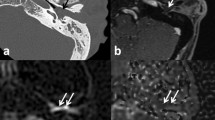Abstract
To analyze the apparent diffusion coefficient (ADC) values of middle ear and mastoid lesions in Diffusion weighted Magnetic Resonance Imaging (DW-MRI) to arrive at a probable demarcating value to differentiate cholesteatoma from non-cholesteatomatous lesions. Accurate anatomic localization of the lesion was also done using High Resolution Computed Tomography (HRCT) temporal bone. The study cohort consisted of 30 patients who had undergone HRCT, DW-MRI and surgical intervention in clinically suspected cholesteatomatous lesions during the period August 2018 to August 2020.Sensitivity, specificity, positive predictive value (PPV), negative predictive value (NPV), and accuracy values of HRCT and MRI in relation to intraoperative findings and histopathological findings (gold standard) were calculated and compared using the 2-sided McNemar’s Chi Square test. Receiver operating characteristic (ROC) curve was used to predict the cut off value of ADC to differentiate between cholesteatoma and non cholesteatomatous lesions. Total patients were 30 out of which 15 were histopathologically proven cholesteatoma. MR DWI showed 100% sensitivity, 80% specificity, and 90% accuracy in diagnosing cholesteatoma compared to HPE. The probable cut off value of ADC in differentiating cholesteatoma from non-cholesteatomatous lesions was found to be < 1.226 × 10–3 mm2/s, statistically using ROC curve. HRCT showed 96.6% accuracy in identifying the location of the lesion. MR-DWI is a useful tool both individually and in combination with HRCT in the diagnosis of cholesteatomas with high accuracy. An ADC cut-off value could also significantly help increase the accuracy of diagnosis.


Similar content being viewed by others
References
Rout MR, Mohanty D, Vijaylaxmi Y, Kamalesh B, Chakradhar M (2012) Prevalence of cholesteatoma in chronic suppurative otitis media with central perforation. Indian J Otol 18(1):7
Tos M (1988) Incidence, etiology and pathogenesis of cholesteatoma in children. Pediatric Otology . Karger Publishers 40: 110-117
Kemppainen HO, Puhakka HJ, Laippala PJ, Sipilä MM, Manninen MP, Karma PH (1999) Epidemiology and aetiology of middle ear cholesteatoma. Actaoto-laryngologica 119(5):568–572
Pusalkar AG (2015) Cholesteatoma and its management. Indian J Otolaryngol Head Neck Surg 67(3):201–204
Baráth K, Huber AM, Stämpfli P, Varga Z, Kollias S (2011) Neuroradiology of cholesteatomas. Am J Neuroradiol 32(2):221–229
Venail F, Bonafé A, Poirrier V, Mondain M, Uziel A (2008) Comparison of echo-planar diffusion-weighted imaging and delayed postcontrast T1-weighted MR imaging for the detection of residual cholesteatoma. Am J Neuroradiol 29(7):1363–1368
Corrales CE, Blevins NH (2013) Imaging for evaluation of cholesteatoma: current concepts and future directions. Curr Opin Otolaryngol Head Neck Surg 21(5):461–467
Henninger B, Kremser C (2017) Diffusion weighted imaging for the detection and evaluation of cholesteatoma. World J Radiol 9(5):217–222
Vercruysse JP, De Foer B, Pouillon M, Somers T, Casselman J, Offeciers E (2006) The value of diffusion-weighted MR imaging in the diagnosis of primary acquired and residual cholesteatoma: a surgical verified study of 100 patients. Eur Radiol 16(7):1461–1467
Russo C, Elefante A, Di Lullo AM, Carotenuto B, D’Amico A, Cavaliere M & Brunetti A (2018) ADC benchmark range for correct diagnosis of primary and recurrent middle ear cholesteatoma. BioMed research international, 2018.
Locketz GD, Li PM, Fischbein NJ, Holdsworth SJ, Blevins NH (2016) Fusion of computed tomography and PROPELLER diffusion-weighted magnetic resonance imaging for the detection and localization of middle ear cholesteatoma. JAMA Otolaryngol-Head Neck Surg 142(10):947–953
Funding
No external sources of funding involved in this article.
Author information
Authors and Affiliations
Corresponding author
Ethics declarations
Conflict of interest
Authors have no conflict of interest to declare.
Ethical Standards
All procedures performed in studies involving human participants were in accordance with the ethical standards of the institutional and/or national research committee and with the 1964 Helsinki declaration and its later amendments or comparable ethical standards.
Informed Consent
Informed consent was obtained by all individuals participating in the study.
Additional information
Publisher's Note
Springer Nature remains neutral with regard to jurisdictional claims in published maps and institutional affiliations.
Rights and permissions
About this article
Cite this article
Ayyaril, N.A., Chirukandath Jayasankaran, S., Menon, U. et al. Role of Diffusion-Weighted Magnetic Resonance Imaging in the Evaluation of Clinically Suspected Cholesteatoma Cases. Indian J Otolaryngol Head Neck Surg 74 (Suppl 1), 719–723 (2022). https://doi.org/10.1007/s12070-021-02526-8
Received:
Accepted:
Published:
Issue Date:
DOI: https://doi.org/10.1007/s12070-021-02526-8




